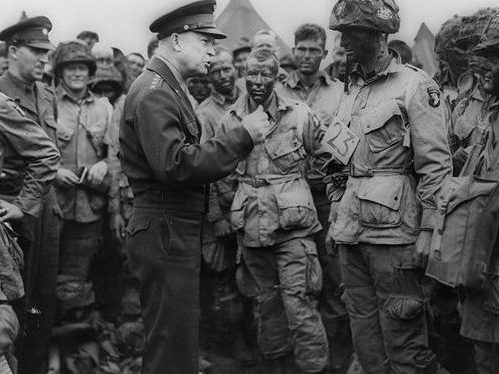
By: Professor Frederick Krantz
6 June 1944 marks the 75th Anniversary of “D” Day” [either “The Day”, or “Deliverance Day”], the Allied landings on the Normandy coast of France. The invasion of Hitler’s “Festung [Fortress] Europa”, opening the “Second Front” long demanded by Stalin, was the beginning of the final chapter in the defeat of the Nazis’ “1,000-Year Reich”.
By now, the Russians in the East, absorbing unimaginable military and civilian casualties (totaling over 23 million by the end of World War II), had defeated the Germans at Stalingrad (winter, 1942-3) and begun their unstoppable advance towards Berlin. The Western Allies’ day-and-night strategic bombing of Germany was long underway, North Africa and Italy had already been occupied, and almost complete control of the air and sea (“Battle of the Atlantic”) secured
Operation Overlord was the greatest amphibious landing of all previous history. 6,939 ships (including six battleships, twenty-three cruisers, 102 destroyers, 800 cargo ships, 4,000 landing craft), 12,000 aircraft (flying 11,000 sorties), and a total of 2 million personnel transported and supported 154,000 soldiers (including 24,000 parachutists and glider-borne troops). Seventy-thousand five-hundred Americans, 69,000 British and 14,000 Canadians–with innumerable tanks, artillery pieces, trucks, and materiel—alighted on the French coast.
American forces landed on Utah and Omaha beaches, to the west, Canadians on Juno, and the British on Gold and Sword to the east, a front stretching some 50 miles between Cherbourg and Caen.
Part of the landing plan ordered by Allied Commander-in-Chief Dwight D. Eisenhower was a successful deception campaign. Massive false installations in England, including a phony “First U.S. Army Group” opposite Calais supposedly led by General George S. Patton (much feared by the Nazis), and clever disinformation, convinced the Germans that the imminent landing would probably come at Calais, the point nearest the English coast and far west of the actual landing beaches.
As a consequence, the Germans—who under General Erwin Rommel, the “Desert Fox”, had fortified much of the “Atlantic Wall” along the Channel coast–concentrated their forces, including their best Panzer (armored) divisions, near Calais.
These forces were not inconsiderable: Generalfeldmarschall Gerd von Rundstedt, who as Commander-in-Chief West was Rommel’s superior officer, commanded almost 1 1/2 million Wehrmacht troops, 850,000 in army units. But they were widely-dispersed, of varying quality and often poorly equipped.
Of thirty-six available infantry divisions. Some were composed largely of veterans wounded in earlier campaigns, of older troops as well as “Volksdeutsch” (East Europeans of German extraction) and (often unreliable) “Osttruppen”, men recruited from Soviet and Polish prisoners of war.
The Panzer and Panzergrenadier troops, however, were of much higher quality, and included highly-motivated Waffen SS divisions like Leibstandarte Adolph Hitler, Hitler Jugend, and Das Reich.
Although surprised and thrown off balance by the unexpected size and siting of the invasion, and by the paratroops landings behind their lines which cut communications and transport routes, the well-entrenched and protected German forces were not easily dislodged. And German armored forces, although delayed and decimated by Allied air power, once deployed took their toll.
June 6, 1944, saw ca.9,000 Allied casualties, almost half fatal: 2,500 Americans would die on Utah and Omaha beaches, 1,641 British on Gold and Sword, and on Juno the Canadians suffered over 1,000 Canadian casualties, including 359 deaths.
But by the end of 6 June, 156,000 Allied soldiers were ashore, and the Germans, their counter-attack blunted, had been thrown back. By 14 June 500,000 had landed, and by 17 July, over 1 million, with 150,000 vehicles and half a million tons of supplies. Eisenhower, who had feared the tragic consequences of possible defeat, had, through meticulous planning, massive force, great determination, and his forces’ heroic sacrifice, triumphed, tactically and strategically.
The bridgehead established, Allied troops moved inland, fighting bitterly through the bocage (hedgerows), taking Cherbourg and Caen, and trapping many fleeing Germans in the Falaise Gap. The three-months’ campaign into north-western France led on to the fall of Paris on 25 August, 1944, and beyond.
The Wehrmacht would suffer some 240,000 deaths and 200,000 taken prisoners, while the Allies endured a total of ca. 226,000 casualties (including 16,714 airmen). These are staggering figures, directly comparable, as the historian Alan Kershaw observes, to the great Soviet-German battles on the Eastern Front.
That winter, after the Americans bloodily repulsed the Germans’ final, desperate surprise offensive in the Ardennes Forest at the Battle of the Bulge, the Allies resumed the attack, crossing the Rhine and meeting up with the Red Army in Saxony, at Torgau. on the Elbe. In April, the Russians would finally attack, and conquer Berlin, where, Hitler, his cause irretrievably lost, committed suicide on 30 April. Germany’s final, unconditional surrender came on May 8-9, 1945.
June 6, 1944, the invasion of Normandy, had sealed the fate of Nazi Germany. The “Thousand-Year Reich”–which had caused, with its Japanese and Italian Axis allies, the deaths of over 60 million people, including over 6 million Jews–suffered total, complete, and crushing defeat, lasting exactly 12 years.
(Prof. Frederick Krantz is Director of the Canadian Institute for Jewish Research, and Editor of the Daily Isranet Briefing)





